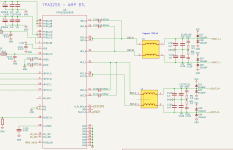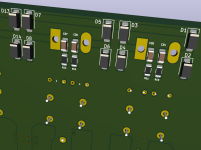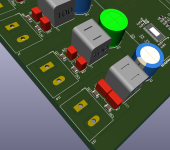Hey everyone!
I am currently designing a 6 channel class D amplifier with DSP using the TPA3255 chips. One thing I am really concerned about with class D is the possibility of damaging the amplifier when no load is connected to the output of the LC filter. On the forums, I heard of people using load resistors to keep the amp loaded to some degree or using catch diodes to clamp the maximum LC filter to the voltage rails (PVDD and GND) so that the fly back effect does not go back in to the amp and damage the output stage of the IC. I am most keen on using the diode protection method, but where do I place the diodes? Do I place it before or after the LC filters? I seen Wondom amplifier boards place the catch diodes after the LC filter right before the outputs, but I also seen amps like the TDA7498E that place the catch diodes before the LC filters. Any suggestions?
I am currently designing a 6 channel class D amplifier with DSP using the TPA3255 chips. One thing I am really concerned about with class D is the possibility of damaging the amplifier when no load is connected to the output of the LC filter. On the forums, I heard of people using load resistors to keep the amp loaded to some degree or using catch diodes to clamp the maximum LC filter to the voltage rails (PVDD and GND) so that the fly back effect does not go back in to the amp and damage the output stage of the IC. I am most keen on using the diode protection method, but where do I place the diodes? Do I place it before or after the LC filters? I seen Wondom amplifier boards place the catch diodes after the LC filter right before the outputs, but I also seen amps like the TDA7498E that place the catch diodes before the LC filters. Any suggestions?
Catch diodes before the filters will protect the ic but not the filter caps. At certain frequencies an unloaded LC will produce voltage GAIN.
Thus taking out the caps.
Thus taking out the caps.
I am most keen on using the diode protection method, but where do I place the diodes? Do I place it before or after the LC filters? ... Any suggestions?
Placing these diodes before the filter would simply be 'redundant' as the MOSFETs already have body diodes built into their structure. I would place them after.
This is a known issue in 'pre-filter feedback' amplifiers.One thing I am really concerned about with class D is the possibility of damaging the amplifier when no load is connected to the output of the LC filter.
I heard of body diodes somewhere else too (tpa3116 forums I believe) but if I placed them after the filter, should I place it before the zobel network or after the zobel. As you mentioned pre filter feedback, would I be able to crank my volume to the absolute max on unloaded channels as well without damage? I want my class D amp to behave like a class AB in terms of functionality. By the way my amp design does not use PFFB
With a Zobel network, there should be no need for such protection, as it would damp out the unloaded filter resonance to a good extent. Besides, filters are designed to cutoff just above the audio range so that they do not resonate near the PWM frequency.
Interesting. I still wonder why there are reports of class D amps blowing up without load? XRK audio said that the only time he seen tpa32xx ICs blow up is either due to a) bad bootstrap capacitors or b) running at high power without load. So if the zobel dampened the filter, why will it still blow up? Is it because of a poor tuning of the zobel?With a Zobel network, there should be no need for such protection, as it would damp out the unloaded filter resonance to a good extent. Besides, filters are designed to cutoff just above the audio range so that they do not resonate near the PWM frequency.
I have thought of this before, but it seems like class D amplifiers will have too much voltage gain at impedances much greater than the filter's tuning, and will still destroy the amplifier. I think it's like increasing both the Q and amplitude boost (in db) in a parametric filter as you approach a higher impedance. But I am not sure if my understanding is right or wrong.Just putting a 10k load resistor wouldn`t help?
That's what I have currently and will something like this work?I would use post filter diodes to the supply rails.
Attachments
The diodes should work, they will clip output signal ringing to rails.
The ringing can be way above the rails with no load which can damage the filter capacitor if not sufficient voltage rating.
The ringing can be way above the rails with no load which can damage the filter capacitor if not sufficient voltage rating.
So in this case, are the caps before the diodes (1uf 100V, 1nf 250v, Zobel network (cap is around 250V rating for that one) be unprotected? And how much greater will the ringing be above the rails? Also, does this layout for the diodes on the PCB look fine?The diodes should work, they will clip output signal ringing to rails.
The ringing can be way above the rails with no load which can damage the filter capacitor if not sufficient voltage rating
Attachments
All 'class d amps' are not the same and some are poorly designed and some probably by designers of linear amplifiers. Some don't need Zobel networks but many don't have.Interesting. I still wonder why there are reports of class D amps blowing up without load?
If I were you I'd just put the diodes and finish it off instead of asking for trouble.So in this case, are the caps before the diodes (1uf 100V, 1nf 250v, Zobel network (cap is around 250V rating for that one) be unprotected?
Last edited:
- Home
- Amplifiers
- Class D
- Protecting Class D amplifiers from no load conditions


